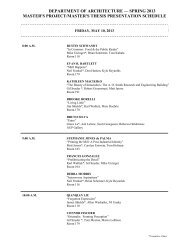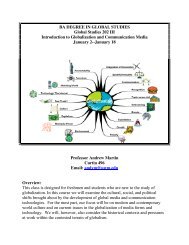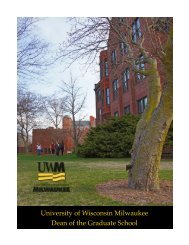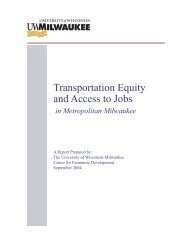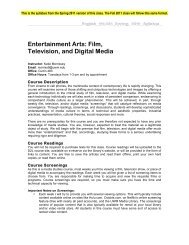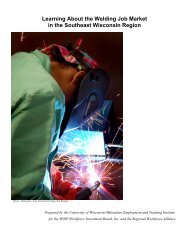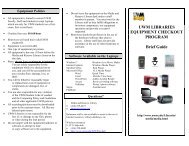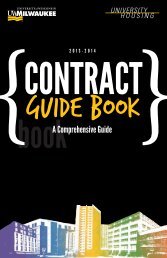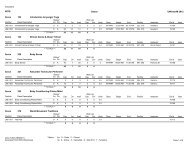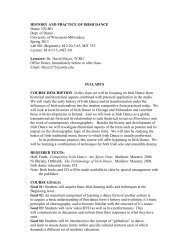FALL 2008 - UW-Milwaukee
FALL 2008 - UW-Milwaukee
FALL 2008 - UW-Milwaukee
You also want an ePaper? Increase the reach of your titles
YUMPU automatically turns print PDFs into web optimized ePapers that Google loves.
S T U D E N T P R O F I L ECatherine VanLeerBy Lee Abbott“ How do you get people to beengaged in their community?How do you get people to beproactive, when all they’ve seen ispoverty?” Catherine VanLeer has beenthinking about these issues for a longtime. Though they might seemsurprising questions to be asked by astudent and (now) practitioner ofarchitecture, thoughts like these frameVanLeer’s understanding of how spaceand society interrelate. “Surroundingsreflect the internal conditions ofhome,” she continues. “Joblessness,lack of fathers in homes: the neighborhoodis a reflection of the issues.” Arecent graduate of <strong>UW</strong>M’s School ofArchi tecture and Urban Planning,VanLeer admits that, with this concernfor social issues, she should probablybe going into policymaking. Sherecognizes that the conditions ofneighborhoods encompasses both thearrangement of buildings and streets,and the ways communities affect andare affected by the built space aroundthem.Now interning for the architecturalfirm Holabird & Root in Chicago,VanLeer remarks on her transformationfrom student to architect. Thistransition began last summer, whenVanLeer worked at the firm on therestoration and preservation of theTiffany glass dome in the ChicagoCultural Center. Starting this summer,she is working with a team that’sdesigning a charter school, a pharmacyschool, and a private residence.Although she finds this work fulfillingand important, VanLeer considers herpresent work an initiation to her futurecareer in urban planning and policy.But VanLeer’s first initiation tothe place where architecture andpolicy intersect was her experience ofgrowing up low-income and AfricanAmerican in <strong>Milwaukee</strong>’s NorthwestSide and Riverwest neighborhoods.Memory and geography intersect asshe describes the issues and ideas thatmotivate her work, and the largerpurpose she sees in her career. “I feellike I have a stake in it; like I can offera greater understanding; a clear andconcise voice on the communities andhelp create better spaces.” Herexperience has helped her acknowledgeand critically understand how therealities of race and class remainrelevant to the work of her chosencareer in architecture and urbandesign. VanLeer describes the placeswhere she grew up in terms of therelationship she and her family had tothe space around them. “What I likedabout my community was that on ourblock, we would see the conveniencestore. Everyone was there — I had thefeeling that this was my store. Theowner would give my mother storecredit.” The relationship, VanLeerrecalls, between the store owners andthe families was deeper than just thatof acquaintances. What she describesis something like an “ethics” of space— a way that a place was situated orcreated that also met the ethical andmaterial needs of the community.Using the insights from herupbringing — raised along with fivesiblings by her mother — and thecourse readings from her professors,VanLeer has developed her owncritical perspectives about the placesand communities she’s observed. ForVanLeer, “the use of space is cultural.”She explains that, where her motherlives, there are many children playingin front of the houses. As an exampleof “the cultural use of space,” shenotices how Latinos and blacks tendto socialize on the front lawn. Havinglived on the East Side, too, shenoticed and studied how whites tendto socialize in their back yards. “OnHolton Street, you see socializing inthe front. You might view this asnegative — and the media plays intothis perception — [instead] it needsto be viewed as cultural.” VanLeeroften returns to urban theorist JaneJacobs’ concept of “eyes on the street”to think past the misconceptions andnegative media images of workingclass areas and communities of color.“A safer neighborhood is when peopleare out,” she notes.Having this critical analysis of theuse of space provides ways to understandthe problem posed at the beginningof this article. “The neighborhood isa reflection of the issues,” and forVanLeer, finding solutions to the issuesof poverty and inequality require anunderstanding of the cultural uses ofbuilt sur rounding, and recognizing thepositive ways communities look out foreach other.Fall <strong>2008</strong>/Myriad 13



